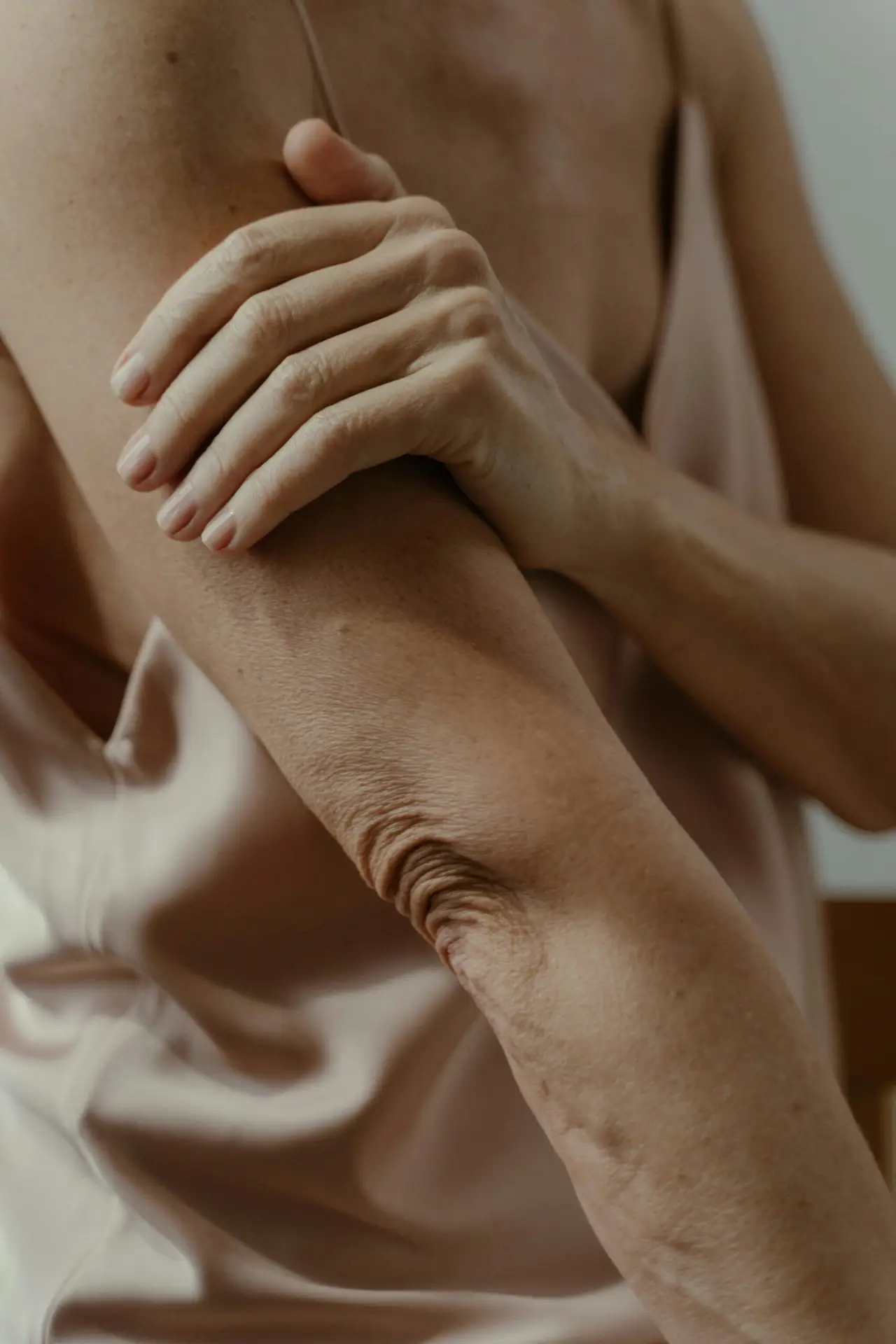
Why Won’t my Elbow Stop Itching? If you’ve been chasing an itch on the outer forearm or around the elbow that refuses to quit—no rash, no bug bite, no clear reason—you’re not imagining it. That stubborn, deep itch has a name: Brachioradial Pruritus (BRP). And while lotions and antihistamines rarely touch it, there’s very often a root cause hiding in plain sight—your neck, especially the delicate, powerful junction where the head meets the spine.
In Sarasota and Manatee County, we see this every week. When the upper cervical spine is out of alignment, the sensory nerves that carry “itch” signals can become irritated, sending false alarms to the brain. The result? A relentless itch that feels like it lives beneath the skin.
At Lavender Family Chiropractic in Sarasota, our team—Dr. Rusty Lavender, Dr. Jacob Temple, and Dr. Will Guzinski—focuses on gentle, precise upper cervical chiropractic designed to correct misalignments at their source (without twisting, popping, or cracking). With 3D CBCT scans and functional nervous system scans (Tytron paraspinal infrared thermography), we help patients finally connect the dots between neck alignment, nerve health, and the strange, maddening symptoms of BRP.
Below, you’ll find the most comprehensive, patient-centered guide we can offer: what BRP is, why it happens, how to tell if your neck is involved, what real relief looks like, and how upper cervical care can help you get your life—and your sleep—back.
Why Won’t my Elbow Stop Itching? What Exactly Is Brachioradial Pruritus (BRP)?
Brachioradial Pruritus is a neuropathic itch syndrome, which means the problem originates in the nervous system, not the skin. Most patients describe a burning, tingling, crawling, or intensely itchy sensation on the outer forearm, often near the elbow (over the brachioradialis muscle). It may affect one arm or both, and it often flares in warm weather or after sun exposure. Unlike allergic rashes, there’s typically no primary skin finding—the redness or scabbing you see comes from scratching, not from the underlying cause.
BRP frequently ties back to irritation of cervical nerve roots—commonly C5–C6—that transmit sensation from the forearm to the brain. When those nerves are irritated or compressed, they can misfire, generating a persistent sense of itch that ice temporarily numbs but lotions seldom soothe.
Classic Symptoms of Brachioradial Pruritus
- Intense itching, burning, or stinging localized to the outer forearm and/or elbow
- Deep, internal itch that scratching cannot satisfy
- No obvious rash (secondary redness or scabs may appear from scratching)
- Worse with heat and sunshine, often flaring in the summer or after outdoor activities
- Nighttime aggravation, disrupting sleep and concentration
- “Ice-pack sign”: rapid, reliable relief when you place ice on the area—one of the biggest clues that the itch is neuropathic
- Episodes that come and go in flares, sometimes switching sides or spreading
If you’ve tried steroid creams, moisturizers, antihistamines, even prescription topicals with minimal or fleeting results, BRP should be high on the list.
Why Skin-First Treatments Often Fail
Traditional approaches typically start with the skin: moisturizers, steroids, antihistamines, anti-itch lotions. They make sense for eczema or contact dermatitis—but BRP isn’t a skin disease. It’s a nerve signaling issue. If the sensory pathway is irritated upstream (in your neck), treating the downstream signal (the skin) is like lowering a smoke alarm’s volume while the wires are shorting out.
Neuropathic itching demands a neurological solution. That’s why patients with true BRP often say, “Only ice helps.” Ice temporarily calms the local nerve endings and can dampen the firing pattern—but it doesn’t address why the nerve keeps misfiring.
Where the Neck Comes In: The Upper Cervical Connection
Your upper cervical spine—the atlas (C1) and axis (C2)—surrounds the brainstem, the master switchboard for sensory processing, balance, and autonomic function. Even a small misalignment at this level can disturb neural traffic: the way signals from the arms, face, and scalp are filtered and interpreted.
Here’s the chain we often see:
- Atlas/Axis misalignment alters the head–neck relationship and adds torque to the cervical cord and nerve roots.
- Compensations develop at lower cervical levels (commonly C5–C6), where nerves that serve the outer forearm exit.
- Irritated or compressed nerve roots begin sending aberrant signals, which the brain perceives as itch, burning, or pins-and-needles.
- Inflammation feeds the cycle, posture worsens, and the nervous system becomes hypersensitized—small triggers now create big responses.
Correcting the upper cervical alignment doesn’t just “crack the neck.” Done properly (and gently), it restores the biomechanics and neurological balance that let those sensory nerves quiet down.
Common Triggers and Aggravators of BRP
- Sun/UV exposure (possibly increasing local nerve excitability and inflammation)
- Heat and sweating, which amplify skin sensitivity and vasodilation
- Forward head posture and prolonged screen time (mechanical stress on the cervical spine)
- Old injuries: whiplash, sports collisions, or falls that subtly shifted atlas/axis alignment
- Degenerative changes: disc height loss, osteophytes, or facet irritation at C5–C6
- Stress and poor sleep, which lower thresholds for nerve firing and pain/itch perception
None of these explain everything, but each can nudge sensitized nerves into flare mode—especially when upper cervical misalignment is quietly driving the system toward irritability.
How Upper Cervical Chiropractic Is Different (and Why It Helps BRP)
Upper cervical chiropractic is not a general, full-spine twisting routine. It’s a precision specialty focused on the top of the neck, where millimeters matter. At Lavender Family Chiropractic we:
- Perform 3D CBCT imaging to see the atlas and axis in three dimensions—no guesswork.
- Use Tytron functional nervous system scans to map autonomic stress patterns along the spine.
- Analyze posture, balance, and neurologic reflexes to understand compensations from head to toe.
- Deliver a gentle, specific, non-twisting correction tailored to your exact misalignment vector.
- Re-scan to confirm objective changes in nervous system tone—then we let your body do the healing.
When the upper cervical relationship is restored:
- Nerve root irritation can ease.
- Blood and CSF microdynamics (cerebrospinal fluid) can normalize.
- Autonomic “fight-or-itch” bias often calms.
- The brainstem processes peripheral signals more accurately.
- That deep, inexplicable itch begins to fade—often in frequency first, then in intensity.
What to Expect at Lavender Family Chiropractic (Step-by-Step)
- Conversation and History
We listen: Where exactly is the itch? When did it begin? Sun exposure? Old whiplashes? What has helped (ice) and what hasn’t (creams)? Any numbness, tingling, or weakness? - Functional Nervous System Scans
Tytron thermography helps us visualize temperature asymmetries related to autonomic nerve stress. Think of it like a heat map for nerve irritation. - 3D CBCT Imaging
High-resolution cone-beam CT reveals subtle misalignments of C1/C2 impossible to see on standard films. We measure in fractions of a degree to craft your correction. - Gentle, Precise Correction
A targeted, non-rotational adjustment to the upper cervical spine—no popping or cracking. Most patients are surprised by how light it feels. - Post-Adjustment Rest and Re-Scan
We allow the nervous system to adapt, then re-check objective measures. Many people register softer muscle tone and easier breathing immediately. - Stabilization Plan
We prioritize holding the correction, not frequent re-adjusting. Customized follow-ups, posture strategies, hydration/sun routines, and sleep coaching help you stabilize and heal.
Sarasota Case Snapshots (Names Changed for Privacy)
- “S.” from Lakewood Ranch: Three years of left forearm itching, worst after beach days. Dermatology ruled out eczema; ice was the only relief. CBCT showed atlas rotation and head tilt to the left; Tytron showed left-sided autonomic heat asymmetry. After three precise upper cervical corrections over four weeks, the itch episodes dropped from daily to once every 3–4 days, and intensity fell from 9/10 to 3/10. At three months, rare flares occurred only after long sun exposure—managed with better neck posture, hydration, and a UPF sleeve for kayaking.
- “D.” from Bradenton: Construction worker with forward head posture and prior rear-end collision. Itch ping-ponged between arms, worse at night. CBCT revealed C2 angulation with compensatory stress at C5–C6. Within six visits, sleep normalized. By two months, “the itch that used to hijack my evenings” essentially resolved.
- “J.” from Siesta Key: Golfer, avid in the sun. BRP every spring/summer. With atlas correction and seasonal strategies (UPF clothing, post-round icing, hydration, cervical decompression routine), she completed her first itch-light summer in a decade.
Everyone’s timeline is different—neuropathic patterns can be stubborn—but when the root mechanical driver at the upper cervical spine is addressed, the trajectory changes for good.
Differential Diagnosis: If It’s Not BRP, What Else Could It Be?
- Eczema/Atopic Dermatitis – Usually presents with visible rash, dryness, and responds (at least partially) to topical therapies.
- Contact Dermatitis – Clear trigger (new detergent, topical product, gear). Removing the irritant improves symptoms.
- Notalgia Paresthetica – Neuropathic itch on the back (often between shoulder blades), tied to thoracic nerve entrapment.
- Shingles (Herpes Zoster) – Itch/burning with blistering rash along a dermatomal pattern; often painful.
- Cervical Radiculopathy – Nerve root irritation with pain/tingling/numbness and possibly weakness; can coexist with BRP.
- Systemic Itch – Thyroid, liver, kidney, iron or B12 issues can cause generalized itch (less commonly localized to the lateral forearm).
A good evaluation rules out skin-driven causes, then investigates the cervical spine when the story fits (ice helps, topicals fail, heat/sun aggravate, nocturnal flares).
The Anatomy—Simplified and Useful
- C1 (Atlas) and C2 (Axis): The “tripod” that holds your head. Misalignments here tug on the dura, alter brainstem signaling, and distort global posture.
- C5–C6 Roots: Sensory supply for the lateral forearm and elbow region. Irritation here can produce itch, tingling, or burning without visible skin disease.
- Brainstem/Trigeminal–Cervical Complex: A hub where neck input influences facial and cranial sensory processing. When overexcited, peripheral sensations can be misinterpreted or amplified.
- Autonomic Network: Sympathetic overdrive (our “stress gear”) heightens all sensations—pain, itch, light, sound. Calming the system starts at the top of the neck.
When the head sits squarely on a balanced atlas/axis, neural traffic quiets. Signals become clearer. False alarms—like the phantom itch of BRP—lose their megaphone.
Home Strategies That Support Recovery (While We Address the Root)
- The Ice Test (Don’t Overuse): Use a wrapped ice pack for 5–10 minutes to break a severe flare. Helpful, but think of it as a bridge, not the fix.
- Sun-Smart Habits: UPF sleeves, hats, shade breaks, and post-exposure cool-downs. Many patients notice a dramatic difference with simple sun discipline.
- Hydration & Minerals: Well-hydrated tissues conduct signals more predictably; electrolyte balance matters for nerve stability.
- Screen Posture Intervals: 45–50 minutes of focused work, then 2–3 minutes of posture reset—chin glide, shoulder roll, gentle thoracic extension.
- Sleep Routines: Side sleeping with a supportive pillow that keeps the neck neutral; avoid stomach sleeping that torques C1/C2.
- Nerve-Friendly Nutrition: Emphasize omega-3s, colorful vegetables, and B-complex–rich foods; minimize ultra-processed, inflammatory choices.
- Scratch Alternatives: A cool cloth or gentle pressure instead of nails—protects the skin while we calm the nerves upstream.
These don’t replace a targeted correction, but they stack the deck in your favor while healing happens.
How Long Until I Feel Better?
Timelines vary. Some notice relief in days to weeks; others unwind months or years of nerve sensitization over a few months. Improvement often shows up as shorter flares, less intensity, and longer quiet stretches between episodes. We track objective changes (Tytron scans, posture, range of motion) alongside your symptom diary to keep progress visible.
Why Lavender Family Chiropractic for BRP in Sarasota–Bradenton–Lakewood Ranch
- 3D CBCT Imaging to see what others miss
- Tytron Functional Nervous System Scans to map autonomic stress
- Gentle, Specific Upper Cervical Corrections—no twisting, popping, or cracking
- Personalized Stabilization Plans focused on helping you hold the correction
- A three-doctor team—Dr. Rusty Lavender, Dr. Jacob Temple, Dr. Will Guzinski—with deep experience in complex nerve-driven conditions (BRP, migraines, vertigo, TMJ, occipital neuralgia)
We serve Sarasota, Bradenton, Lakewood Ranch, Parrish, Ellenton, Venice, Osprey, Punta Gorda, St. Petersburg, Siesta Key, Longboat Key, Lido Key, and Myakka City. If you’re searching “chiropractor Sarasota Florida,” “upper cervical chiropractor near me,” “vertigo doctor near me,” or “migraine doctor near me,” and your stubborn elbow/forearm itch keeps stealing your peace, we’d love to help you write a different story.
Top 15 FAQs About Brachioradial Pruritus and Upper Cervical Care
- What is Brachioradial Pruritus in plain language?
A deep, nerve-based itch on the outer forearm or elbow that typically lacks a rash and often gets worse with heat or sun. It’s a neuropathic itch, not a skin disease. - Why does ice help so much?
Ice dampens local nerve firing, offering quick relief. It’s a hallmark sign that the itch is nerve-driven, not purely dermatologic. - How does my neck cause an itch in my forearm?
Nerve roots in the cervical spine (often C5–C6) carry sensory information from the outer forearm to the brain. Irritation or misalignment in the upper neck can distort those signals, producing a false “itch” message. - I’ve tried steroid creams and antihistamines. Why didn’t they work?
Because the root issue is neurological. Treating the skin doesn’t correct cervical nerve irritation or upper cervical misalignment. - What exactly do you do differently at Lavender Family Chiropractic?
We use 3D CBCT to precisely map your C1/C2 alignment and Tytron scans to assess autonomic stress. Then we deliver a gentle, specific upper cervical correction tailored to you—no twisting or cracking. - Will I need a lot of adjustments?
We focus on helping you hold the correction, not repeated force. Frequency depends on your stability, not a preset schedule. Many patients taper quickly once alignment holds. - Is upper cervical adjusting safe?
Yes. Our technique is gentle and precise. Most patients are surprised by how light the correction feels. - How soon will I notice improvement?
Some feel changes within days; others progress steadily over several weeks. We watch for fewer flares, lower intensity, and improved sleep. - Do you adjust the whole spine?
Our primary focus is the upper cervical region because it drives global balance. When the head is on straight, the rest often follows with far less intervention. - Can upper cervical care help other symptoms too?
Yes. We commonly see improvements in migraines, vertigo/dizziness, TMJ pain, neck pain, occipital neuralgia, and brain fog, because the brainstem’s signaling calms and coordinates better. - What about sun exposure—do I have to avoid it forever?
Not usually. During early healing, be sun-smart (UPF sleeves, shade, hydration). As your nerves settle, many patients reclaim outdoor time with minimal itching. - Is BRP permanent?
Not necessarily. When the underlying neural irritant is corrected and stability is maintained, many people experience long-term relief. - Do you take insurance?
Our office is out of network with insurance. Many patients receive a superbill to submit for reimbursement based on their coverage. We offer multiple payment and financing options. - What tests will you run on the first visit?
History, neurological and postural exams, Tytron scans, and if indicated, 3D CBCT to precisely assess your upper cervical alignment. - How do I get started?
Call (941) 243-3729 or visit www.chiropractorsarasotaflorida.com to schedule your consultation. We’ll listen, measure, and create a plan that makes sense for you.
Encouragement: You’re Not “Just Sensitive”—Your Nerves Are Asking for Alignment
If you’re exhausted from scratching, icing, and explaining a symptom that doesn’t show up on your skin, you’re not alone—and you’re not stuck. Brachioradial Pruritus is real, and it often has a real, correctable driver: upper cervical misalignment. When the head is aligned over the neck, when the brainstem is calm, when C5–C6 aren’t being tugged or torqued, the signal quiets. Relief isn’t a miracle; it’s physiology working again.
At Lavender Family Chiropractic, we’ve walked this journey with people from Sarasota, Bradenton, Lakewood Ranch, Parrish, Ellenton, Venice, Osprey, Punta Gorda, St. Petersburg, Siesta Key, Longboat Key, Lido Key, and Myakka City. The first step is simple: let us measure what’s really going on. If the root is in your neck, we’ll show you—clearly—and we’ll correct it gently.
Lavender Family Chiropractic in Sarasota Florida offers complimentary consultations to learn more about you. Click the link below!
https://intake.chirohd.com/new-patient-scheduling/724/lavender-family-chiropractic
Visit our Website!
To learn more about us go to http://www.chiropractorsarasotaflorida.com
We also service Bradenton, Parrish, Ellenton, Ruskin, Venice, Tampa, St. Pete, Osprey, Longboat, Lakewood Ranch, Myakka City.
If you are in Tampa, Fort Myers, or Salt Lake City, you can visit my other locations! NeckWise Upper Cervical. Visit, www.neckwise.com
If you are not local, visit www.uccnearme.com to find a doctor in your area.
Ready to calm the itch at its source?
Call (941) 243-3729 or visit www.chiropractorsarasotaflorida.com to book your consultation.
You’ve tried creams. You’ve tried ice. Let’s try precision. Let’s try upper cervical. Let’s help your nerves—and your nights—finally exhale.



